WARM UP AND
STRETCHING ACTIVITIES
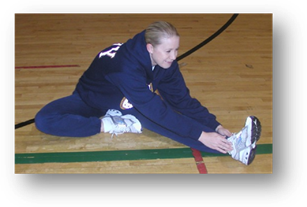
Unit
Overview†
In this unit, you will learn about warming up and stretching before you start any exercise activity.† When training, you should warm up first and then perform flexibility exercises.† You should never perform flexibility exercises when your muscles are cold.
Once you have warmed up and are beginning to stretch, the proper form is to stretch until there is some tension on the muscle.†† Do not bounce or try to reach repeatedly while holding a single stretch. When stretching you should reach and hold the stretch while maintaining the proper position for each specific stretching activity.
You will also be completing another activity log for this week.
- Open another copy of the blank activity log. If you need to download a new copy, you can download it as a PDF file.
- Rename the activity log file, and save it on your computer.
- Remember to have a parent or guardian enter his or her e-mail address at the bottom of the form. This task should be completed by the parent or guardian, not by the student. Doing this is the equivalent of signing the form to verify that the student has completed the activities listed on the activity log. The e-mail address must be valid and belong to the parent/guardian. The teacher may contact the parent/guardian at this e-mail address at any time. The e-mail address will not be used for any purpose other than allowing the teacher to contact the parent/guardian. Entering the parent/guardian e-mail address is the equivalent of signing the form.
Warm
Up
†
You may be psyched to start an exercise program, but you could do more damage than good if you jump right into a marathon run or body-building routine without taking the time to bring your body up to speed.
The idea of taking 5 to 10 minutes to warm up is to literally "warm up" your body or raise the core temperature of your body and your muscles. This allows the muscles to burn calories more efficiently and create energy for exercise. Warm-ups also help prevent injury by improving the elasticity of your muscles, give you better muscle control, and lessen fatigue.
What is a warm-up?
Some people wrongly believe that a warm-up is doing a bit of bending and stretching before exercising. Stretching is not warming up.† It is however an important part of the warming-up process. A warm-up should consist of two steps: (1) a progressive aerobic activity that uses the muscles you plan on exercising during your workout and (2) flexibility or stretching exercises. You should engage in a light activity, such as walking or stationary cycling, for five to ten minutes prior to stretching. A general warm-up can be any light, continuous movements using the large muscle groups, for instance marching or jogging in place. Whatever warm-up you choose should produce a small amount of sweat but shouldn't leave you feeling fatigued.† Then comes stretching, which should be done gently to stretch the muscle.
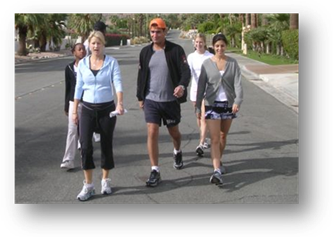
Before you exercise, you should always warm up your body. When you warm up, you are getting your muscles and joints ready to exercise.† Remember, most people are warmed up when they begin to sweat and breathe more heavily. Warming up makes your muscles more limber and decreases your chance of being injured during exercise.
The Purpose of
Warm-Ups
The purpose of warm-ups includes increasing range of motion
of joints, enhancing flexibility, improving coordination, increasing body
temperature and heart rate, increasing blood flow to muscles, and preventing
injuries. The correct way to stretch
is to move slowly and stay relaxed.† DO NOT BOUNCE, because this can
actually cause you to pull the muscle or muscles you are trying to stretch. You should stretch to the point of MILD
TENSION.† If you overstretch, you
may cause damage to your muscles, tendons, or ligaments.† You should stop stretching if you feel any
kind of pain or discomfort. †Hold the stretches for a minimum of 15
seconds each, without bouncing.† You
should breathe slowly and naturally while stretching.† †It is
best to do each stretch one or two times while trying to stretch a little
further with each stretch.
Flexibility
and Stretching Exercises
Neck
Stretch
While sitting or standing with your head in its normal upright position, slowly tilt it to the right until tension is felt on the left side of your neck. Hold that tension for 10 to 30 seconds, and then return your head to the upright position. You should repeat to the left side and then toward the front. Always return to the upright position before moving on.† This stretching exercise helps stretch the muscles in the neck and shoulders.
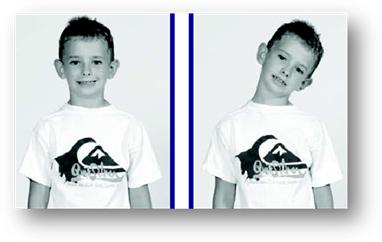
Reach to
the Sky
Stand with feet shoulder-width apart.† Raise both arms overhead so that your hands are intertwined with palms together. Hold for 10 to 30 seconds and relax.† This exercise stretches the muscles in the shoulders, neck, back, and arms.
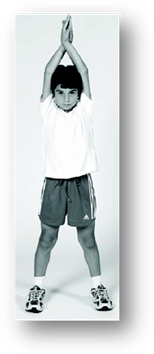
Arm
Circles
Stand with feet shoulder-width apart, and hold your arms straight out to the side with your palms facing up.† Start moving your arms slowly in small circles, and gradually make larger and larger circles. Come back to the starting position, and reverse the direction of your arm swing.† This exercise stretches the muscles in the shoulders and the neck.
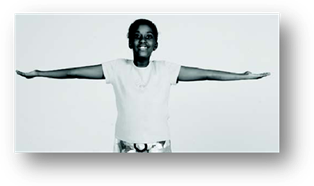
Reach
Back †††††††
††††††
Stand with feet shoulder-width apart, and hold your arms out to the sides with thumbs pointing down.† Slowly move both arms back until you feel tension. Hold for 10 to 30 seconds, and then relax. This exercise stretches the muscles in your chest, shoulders, arms, back, and neck.
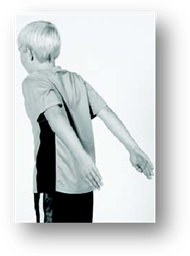
Twister
Sit on a mat with your right leg straight in front of you. Bend your left leg, and cross it over your right leg so that your left foot is alongside your right knee. Bring your right elbow across your body, and place it on the outside of your left thigh near the knee. Slowly twist your body as you look over your left shoulder. Your right elbow should be exerting pressure against your left thigh. Hold the stretch for 10 to 30 seconds, relax, and repeat for the other side.† This exercise stretches the muscles in your lower back and upper legs.
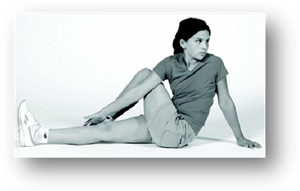
Toe
Touch
While seated, extend both legs in front of you. Keep your back straight, and reach for your toes with both hands without bouncing. Do not bend your knees. Hold this stretch for 10 to 30 seconds. Repeat.† This exercise stretches the muscles in your shoulders, back, arms, and legs.
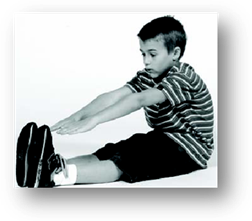
Knee to
Chest
Lie on your back on a mat with your legs straight. Bend your left knee, and bring it up toward your chest. Grasp the underside of your thigh, and slowly pull your thigh to your chest.† Hold for 10 to 30 seconds. Release, and repeat with the right leg.† This exercise stretches the muscles in your legs and buttocks.
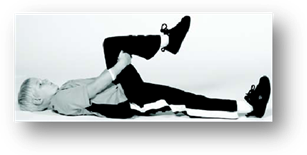
Butterfly
Sit on a mat with your knees bent. Put the soles of your feet (or shoes) together, and hold onto your ankles. Place your elbows on the inner sides of your knees, and slowly apply downward pressure until you feel tension. Hold for 10 to 30 seconds and repeat.† This exercise stretches the muscles in your upper legs and hips.
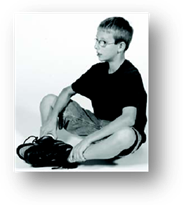
Hurdlerís
Stretch
While seated, place one foot on the inside of the other leg just above your knee.† Keep the other leg extended and straight. With your back straight, press forward toward the thigh of your extended leg. Use your hands for support. When you feel some tension in the back of your leg, hold the stretch for 15 to 20 seconds. Do not bounce while holding this stretch.† Repeat twice with legs in each position.† This exercise stretches the muscles in your legs, arms, hips, and back.
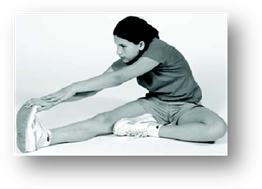
Calf
Stretch
Place your hands against a wall while standing upright. Bend one knee slightly in front of your body while you extend the opposite leg backward until the foot is placed flat on the floor. With your back straight, you should feel some tension in the back of your leg.† Hold the stretch for 15 to 20 seconds, and repeat twice with each leg.† This is a great stretch for the muscles in the lower part of your legs and ankles.
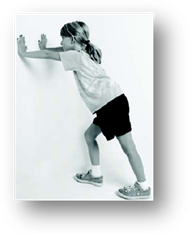
Thigh
Stretch
Keep your body upright, and place the ankle of one of your legs in the hand on the same side of your body. Be sure to keep the leg you are stretching underneath your body and close to the other leg. Hold the stretch for 15 to 20 seconds once you feel some tension in the front of your leg. Repeat twice with each leg.†† This exercise stretches the muscles in your thighs and ankles.
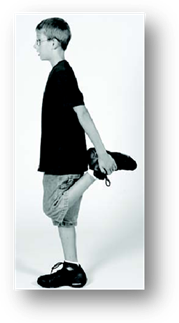
Childís
Pose
Kneel down, and sit back on your feet with your heels pointing outward. Rest your forehead on the floor, relaxing your face, neck, and shoulders. Bring your arms alongside your body with palms turned toward the ceiling. Take 10 to 15 deep, slow breaths. Roll body back up and back down to repeat.† This is a very popular pose used in yoga.
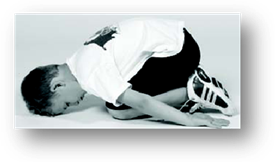
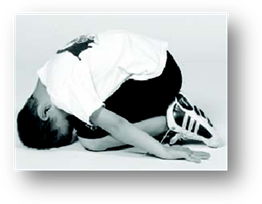
Cat and
Camel
On your hands and knees with your head parallel to the floor, arch your back and then let it slowly sag toward the floor. Try to keep your arms straight.† This is also a popular yoga pose.
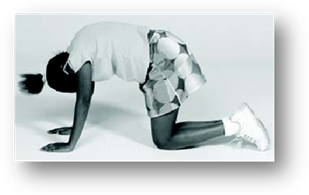
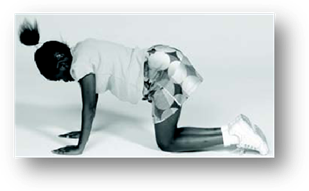
Conclusion
Good luck in your exercise program.† Remember, before you exercise you should always warm up your body. When you warm up your body, you get your muscles and joints ready to exercise. A great way to warm up is to do some walking or light jogging.† Most people are warmed up when they begin to sweat and breathe more heavily. Warming up makes your muscles more limber and decreases your chance of being injured during exercise.† Warm-up, consisting of stretching and flexibility exercises, should be performed for a minimum of 5 to 7 minutes before aerobic exercise or activity.†